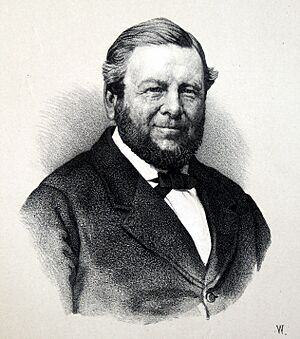Göran Fredrik Göransson facts for kids
Quick facts for kids
Göran Fredrik Göransson
|
|
|---|---|

Portrait of Göransson from the book "Svenska industriens män"
|
|
| Born | 20 January 1819 Gävle, Sweden
|
| Died | 12 May 1900 (aged 81) Sandviken, Sweden
|
| Burial place | Sandviken |
| Nationality | Swedish |
| Occupation |
|
| Spouse(s) |
Catharina Elisabeth Sehlberg
(m. 1842) |
| Children | 6 |
| Parent(s) | Anders Petter Göransson (father) Maria Catharina Elfstrand (mother) |
Göran Fredrik Göransson (born January 20, 1819 – died May 12, 1900) was a Swedish businessman and inventor. He started the company Sandvik (originally called Sandvikens Jernverks AB). He was also the first person to successfully use the Bessemer process on a large scale. This method helped create strong steel for industries.
Contents
Early Life and Learning
Göran Fredrik Göransson was born in Gävle, Sweden, on January 20, 1819. He was the oldest of seven children. His parents were Maria Catharina Elfstrand and Anders Petter Göransson.
He went to school in Gävle. To learn about international business, he spent 18 months traveling. He visited countries like Germany, France, England, and the United States.
A Career in Business
In 1841, Göransson became a partner in his family's business, Daniel Elfstrand & Co. He became the director of the company in 1856. This company was involved in building ships and owning them. It also exported iron and lumber. In 1856, the company bought an iron-works in Högbo and a blast furnace in Edske.
Discovering the Bessemer Process
In May 1857, Göransson traveled to England. He wanted to buy a steam engine for the Edske furnace. He also hoped to get some rights to a new invention called the Bessemer process.
He saw a demonstration of the Bessemer process. Even though some people had doubts, Göransson believed it was a great idea. He even convinced the English inventors that their method was excellent. His support helped the process spread around the world.
He bought one-fifth of the Swedish rights to the patent. This allowed his company to make 500 tons of steel each year. He also ordered equipment for the Edske furnace before returning to Sweden.
Making Steel on a Large Scale
When he returned, the Royal Swedish Academy of Sciences gave him money. This was to help him produce steel using the Bessemer process. This method involved blowing strong air through melted iron. This would burn off impurities like carbon.
However, it was hard to keep the iron hot enough during the process. Göransson's first attempts made steel that was full of waste. But he kept trying. His company, Elfstrand & Co., went bankrupt in December 1857. But his progress with the Bessemer process was so good that the people in charge decided to keep funding his experiments.
The Swedish Ironmasters' Association sent a group to watch his work. They later gave him a loan and a metal expert to help. Finally, on July 18, 1858, Göransson successfully made steel on a large scale. This was a major breakthrough for industry.
Founding Sandvik
On January 31, 1862, he started a new company called Högbo Stål & Jernwerks AB. It was located in Sandviken, Sweden. He showed off the successful Bessemer process at an exhibition in London in 1862.
However, the company faced financial problems in 1866. In 1868, the company was reorganized and renamed Sandvikens Jernverks AB. His oldest son, Anders Henrik Göransson, became the managing director. Göransson himself became the company's chairman in 1883.
The company quickly grew in other countries like Germany, Great Britain, and the United States. This was largely because of Göransson's many connections abroad.
Family and Lasting Impact
Göransson married Catharina Elisabeth Sehlberg on May 31, 1842. They had four sons and two daughters. His oldest son, Anders Henrik, later became the managing director of Sandvikens Jernverks AB. He also took over as chairman after his father's death.
Göransson is often called the "father of ingot steel." This is because he improved the Bessemer process. His work made it possible to produce steel in huge amounts for industries.
He also founded the town of Sandviken in 1862. It started as a small fishing village. But it grew into a busy town around the steelworks he built. Most people in Sandviken worked for his company or depended on it.
In the 1860s, Göransson started a foundation called Stiftelsen den Göranssonska Fonden. This foundation helped his company's employees and their families. Today, this foundation and two others started by his family still help people. They fund student grants and care for the elderly, disabled, and sick in the Sandviken area. The foundation also helped build the Göransson Arena. This is a large indoor stadium named after him.
Göran Fredrik Göransson passed away on May 12, 1900, in Sandviken. He is buried in the Sandviken cemetery.
Honors and Recognition
- Grand Cross of the Order of Vasa
- Knight of the Order of the Polar Star
- Jernkontoret's grand gold medal
- Member of the Royal Swedish Academy of Sciences

